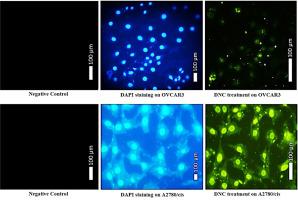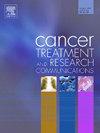Dendrosomal Curcumin Nanoformulation induces apoptosis via Bax/Bcl-2 in human ovarian cancer OVCAR3 cells
IF 2.4
Q3 Medicine
引用次数: 0
Abstract
Introduction
Curcumin (Cur), a yellow polyphenolic compound derived from the rhizome of turmeric, exhibits potent chemopreventive and chemotherapeutic properties. However, its clinical application as an anticancer agent is hindered by poor water solubility and low bioavailability. To overcome these limitations, the present study introduces a novel nanoformulation in which curcumin is effectively encapsulated within 142 nm spherical dendrosomes, which serve as a non-toxic nanocarrier.
Methods
The morphological changes in OVCAR3 ovarian cancer cells were assessed using both inverted light microscopy and fluorescence microscopy. Cell cycle distribution was analyzed by flow cytometry using the MultiCycler software. Cells were treated with dendrosomal curcumin (DNC), oxaliplatin (Oxa), or a combination of both for 48 hours. Protein expression levels were analyzed by western blotting using enhanced chemiluminescence (ECL) detection.
Results
Dendrosomal curcumin improves curcumin’s bioavailability and therapeutic potential in cancer treatment. Treatment with DNC and Oxa individually resulted in significant induction of apoptosis in OVCAR3 cells. The combination therapy further amplified this effect compared to either agent alone. Molecular analyses revealed upregulation of pro-apoptotic Bax and downregulation of anti-apoptotic Bcl-2 at both mRNA and protein levels, supporting the activation of apoptotic pathways.
Conclusion
Our findings demonstrate that both DNC and Oxa induce apoptosis in OVCAR3 ovarian cancer cells through modulation of Bax and Bcl-2 expression. The enhanced efficacy observed in combination therapy highlights the therapeutic potential of DNC, in conjunction with conventional chemotherapeutics, as a promising strategy for ovarian cancer treatment.

姜黄素纳米制剂通过Bax/Bcl-2诱导人卵巢癌OVCAR3细胞凋亡
姜黄素(curcumin, Cur)是一种从姜黄根茎中提取的黄色多酚化合物,具有有效的化学预防和化学治疗特性。但其水溶性差、生物利用度低,阻碍了其作为抗癌药物的临床应用。为了克服这些限制,本研究引入了一种新的纳米配方,其中姜黄素被有效地封装在142纳米的球形树突内,作为无毒的纳米载体。方法采用倒置光镜和荧光显微镜观察OVCAR3型卵巢癌细胞的形态学变化。用multicycle软件流式细胞术分析细胞周期分布。用树突体姜黄素(DNC)、奥沙利铂(Oxa)或两者联合治疗细胞48小时。用增强化学发光(ECL)检测western blotting分析蛋白表达水平。结果树状体姜黄素提高了姜黄素的生物利用度,提高了姜黄素在肿瘤治疗中的应用潜力。DNC和Oxa单独处理可显著诱导OVCAR3细胞凋亡。与单独使用任何一种药物相比,联合治疗进一步放大了这种效果。分子分析显示,在mRNA和蛋白水平上,促凋亡Bax上调,抗凋亡Bcl-2下调,支持凋亡通路的激活。结论DNC和Oxa均通过调控Bax和Bcl-2的表达诱导OVCAR3型卵巢癌细胞凋亡。在联合治疗中观察到的增强疗效突出了DNC的治疗潜力,与传统化疗药物结合,作为卵巢癌治疗的一种有希望的策略。
本文章由计算机程序翻译,如有差异,请以英文原文为准。
求助全文
约1分钟内获得全文
求助全文
来源期刊

Cancer treatment and research communications
Medicine-Oncology
CiteScore
4.30
自引率
0.00%
发文量
148
审稿时长
56 days
期刊介绍:
Cancer Treatment and Research Communications is an international peer-reviewed publication dedicated to providing comprehensive basic, translational, and clinical oncology research. The journal is devoted to articles on detection, diagnosis, prevention, policy, and treatment of cancer and provides a global forum for the nurturing and development of future generations of oncology scientists. Cancer Treatment and Research Communications publishes comprehensive reviews and original studies describing various aspects of basic through clinical research of all tumor types. The journal also accepts clinical studies in oncology, with an emphasis on prospective early phase clinical trials. Specific areas of interest include basic, translational, and clinical research and mechanistic approaches; cancer biology; molecular carcinogenesis; genetics and genomics; stem cell and developmental biology; immunology; molecular and cellular oncology; systems biology; drug sensitivity and resistance; gene and antisense therapy; pathology, markers, and prognostic indicators; chemoprevention strategies; multimodality therapy; cancer policy; and integration of various approaches. Our mission is to be the premier source of relevant information through promoting excellence in research and facilitating the timely translation of that science to health care and clinical practice.
 求助内容:
求助内容: 应助结果提醒方式:
应助结果提醒方式:


